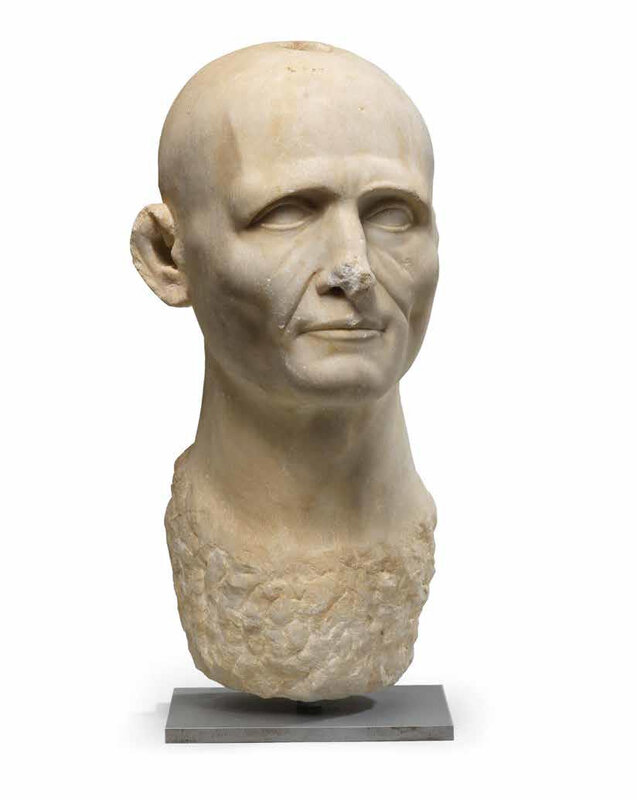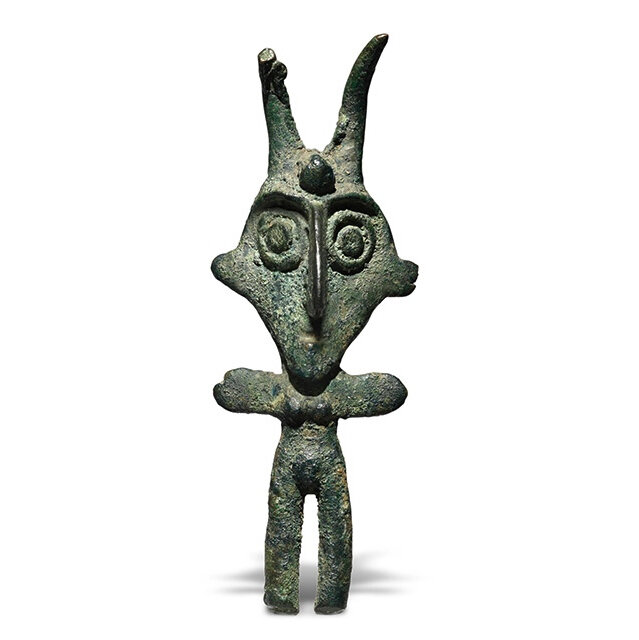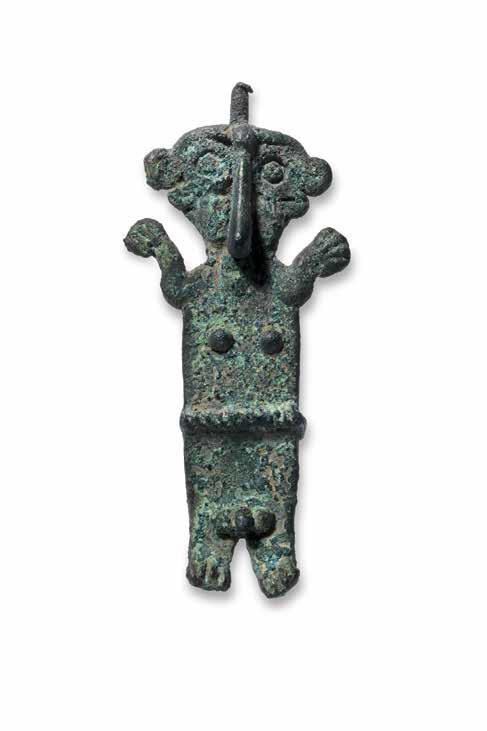Beauty and mystery at Bonhams Antiquities sale
LONDON.- An arresting Roman marble portrait head of a man, possibly a priest, leads Bonhams Antiquities sale in London on Thursday 5 July. It is estimated at £60,000-80,000.
The marble portrait dates from between the 1st Century B.C. and the early 1st Century A.D. The subject is completely bald – a rarity in sculptures of this period – and the reason for that may lie in his vocation. The scalp gives the appearance of having been shaved, which suggests the man might have been a priest of the cult of Isis, which was popular in Rome at the time. Priests of Isis were known to shave their heads as an act of worship. A hole in the crown for the insertion of a separate head-covering – now lost – adds weight to the theory.
Lot 82. A Roman marble male portrait head, Circa 1st Century B.C.-early 1st Century A.D.; 42cm high. Estimate £ 60,000 - 80,000 (€ 68,000 - 91,000). Photo: Bonhams.
Probably a priest, the face powerfully sculpted with large, lidded, unarticulated eyes set deeply beneath prominent brows, a strong, straight nose and pronounced cheekbones, the thin lips closed, the square chin slightly dimpled, with naturalistic wrinkled brow and creased cheeks, the ears sculpted in high relief from the head, a circular hole at the crown of the bald head, probably for insertion of a separately-made head-covering, the back of the head and neck more roughly hewn, the large tenon remaining.
Provenance: Mr Charles Probst, Galerie de la Corraterie, Geneva, 2000.
Swiss art market.
with Bernard Blondeel Kunsthandel, Antwerp, 2005.
Private collection, Belgium.
Note: See F. Johansen, Roman Portraits I, Ny Carlsberg Glyptotek, 1994, p. 74-5, no. 25 for another bald portrait head with similar treatment of wrinkles, lips, and ears sculpted in high relief, dated to the early Augustan period. The hole at the crown of the head was evidently made in antiquity, probably for the insertion of a separately-made head-covering, a feature which would also explain the cursory rendering of the back of the head. Having the head covered in such a manner would characterise the subject as being in the act of sacrificing, and therefore probably a priest; for a comparable priest, see ibid., Roman Portraits II, p. 58-9, no. 17, and Vatican Museums inv. 1751, though in both these examples the head-covering is rendered in the same piece of marble.
The subject of this sculpture is not just bald, but seems to have a fully shaved head. Though completely bald portraits of private individuals from this period are known (see C. C. Vermeule, Greek and Roman Sculpture in America, Berkeley, 1981, no. 232), this fairly unusual element combined with the aforementioned head-covering raises another hypothesis. The practice of shaving one's head is believed to have been an act of worship undertaken by priests of the cult of Isis, which enjoyed popularity in Rome from the late Republican period onwards, notwithstanding a brief period of suspicion about their activities during the reigns of Augustus and Tiberius; cf. a portrait head of a priest of Isis in the Museo Archeologico al Teatro Romano in Verona, which also has a circular hole at the crown. However, the key identifying feature of a priest of Isis is a scar usually visible on the upper forehead or crown of the head (see S. Wood, 'Isis, Eggheads, and Roman Portraiture', JARCE, vol. 24, 1987, p. 123-141 for discussion of the portrait iconography of Isis priests). No such scar is discernible here, and so this attribution must remain uncertain. See also Museo Nazionale Romano, inv. no. 126368 for another shaven-headed male portrait, similar in countenance to the present lot and dating to the late Republican period, and also at times suggested to be a priest of Isis, despite lacking a prominent scar.
The sale also features a private Swiss collection of terracottas, and a European private collection of rare Near Eastern works. Two beautiful Piravend bronze idols from the latter were once owned by André Derain who, with Henri Matisse, was the co-founder of the hugely influential early 20th century art movement, Les Fauves. The figures are said to have been a gift from one of Derain’s sitters, his sometime lover Domenica Guillaume – the wife of his art dealer, Paul Guillaume. Derain’s striking Portrait of Madame Paul Guillaume with a large hat is one of the highlights of the Musée de l'Orangerie in Paris.
The Piravend figures – one male, one female – were made in Western Iran during the 9th – 8th centuries B.C., but little else is known about them. They may have been deities, and the female figure, who appears to be pregnant, could have been a fertility symbol. They were bought at the sale of Derain’s estate in 1956, and have been in the same family ever since. The male figure is estimated at £20,000-25,000, and the female figure at £15,000-20,000.
Lot 124. A Piravend bronze female idol, Western Iran, circa 9th-8th Century B.C.; 8.5cm high Estimate £ 15,000 - 20,000 (€ 17,000 - 23,000). Photo: Bonhams.
With slender legs and short torso with articulated breasts and rounded stomach, the arms outstretched, the oversized head tear-shaped with circular convex eyes with encircling rings set beneath arching brows, large protruding aquiline nose, short, straight mouth and pointed chin, with two horn-like extensions at the crown of the head, a spherical protrusion between.
Provenance: André Derain (1880-1954) collection, Paris, reputedly acquired from Mme Guillaume.
Collection André Derain, vente après décès (premiere vente); Hotel Drouot, Paris, 9-10-11 May 1955, lot 32.
with Françoise Lepage, Paris.
Private collection, Europe, acquired from the above in 1956.
Note: For closely related figures, though depicting males, see The Pomerance Collection of Ancient Art, Brooklyn Museum, 1966, p.35, no. 36 and D. von Bothmer (ed.), Glories of the Past. Ancient Art from the Shelby White and Leon Levy Collection, New York, 1990, p.53, no. 38. In the latter it is noted that these diminutive statuettes probably represent deities, due to their horns, which signify elevation above mortal beings. The present lot's rounded stomach may signify pregnancy, and thus suggest a function as a fertility idol. Beyond these conjectures, however, little is know about the use of, and belief system around, these carefully modelled figures
André Derain was a French artist famous for his uncompromising use of pure color. In 1898, while attending engineering school, he met another up-and-coming artist, Henri Matisse, with whom he began creating art. Their style, based on the use of bright, pure colours, was called Fauvist, or 'wild beasts': Derain is considered a key founder of this new style. In his later career Derain developed his creativity through different styles and mediums, including woodcuts and sculpture.
By repute, this Piravend bronze was donated to the artist by a Mme Guillaume, probably the same woman as the Madame Paul Guillaume, later Madame Jean Walter, painted by André Derain in 1928-1929. The striking portrait is now in the Musée de l'Orangerie in Paris.
Lot 125. A Piravend bronze male idol, Western Iran, circa 9th-8th Century B.C.; 10cm high. Estimate £ 20,000 - 25,000 (€ 23,000 - 28,000). Photo: Bonhams.
Standing on short legs, the rectangular body with male genitalia and pronounced nipples, the arms extended upwards, the triangular face with circular eyes, large protruding beak nose, round cheeks and small ears, wearing a twisted belt around his waist, an attachment loop at rear.
Provenance: André Derain (1880-1954) collection, Paris, reputedly acquired from Mme Guillaume.
Collection André Derain, vente après décès (premiere vente); Hotel Drouot, Paris, 9-10-11 May 1955, lot 31.
with Françoise Lepage, Paris.
Private collection, Europe, acquired from the above in June 1956.

/https%3A%2F%2Fprofilepics.canalblog.com%2Fprofilepics%2F1%2F0%2F100183.jpg)
/https%3A%2F%2Fstorage.canalblog.com%2F03%2F02%2F119589%2F96711876_o.jpg)
/https%3A%2F%2Fstorage.canalblog.com%2F11%2F31%2F119589%2F94773502_o.jpg)
/https%3A%2F%2Fstorage.canalblog.com%2F20%2F83%2F119589%2F94772815_o.jpg)
/https%3A%2F%2Fstorage.canalblog.com%2F26%2F72%2F119589%2F75604929_o.jpg)
/https%3A%2F%2Fstorage.canalblog.com%2F59%2F60%2F119589%2F26458628_o.jpg)





/http%3A%2F%2Fstorage.canalblog.com%2F49%2F93%2F119589%2F129358692_o.jpg)
/http%3A%2F%2Fstorage.canalblog.com%2F04%2F31%2F119589%2F127173660_o.jpg)
/http%3A%2F%2Fstorage.canalblog.com%2F20%2F86%2F119589%2F120616936_o.jpg)
/http%3A%2F%2Fstorage.canalblog.com%2F48%2F88%2F119589%2F120507559_o.jpg)